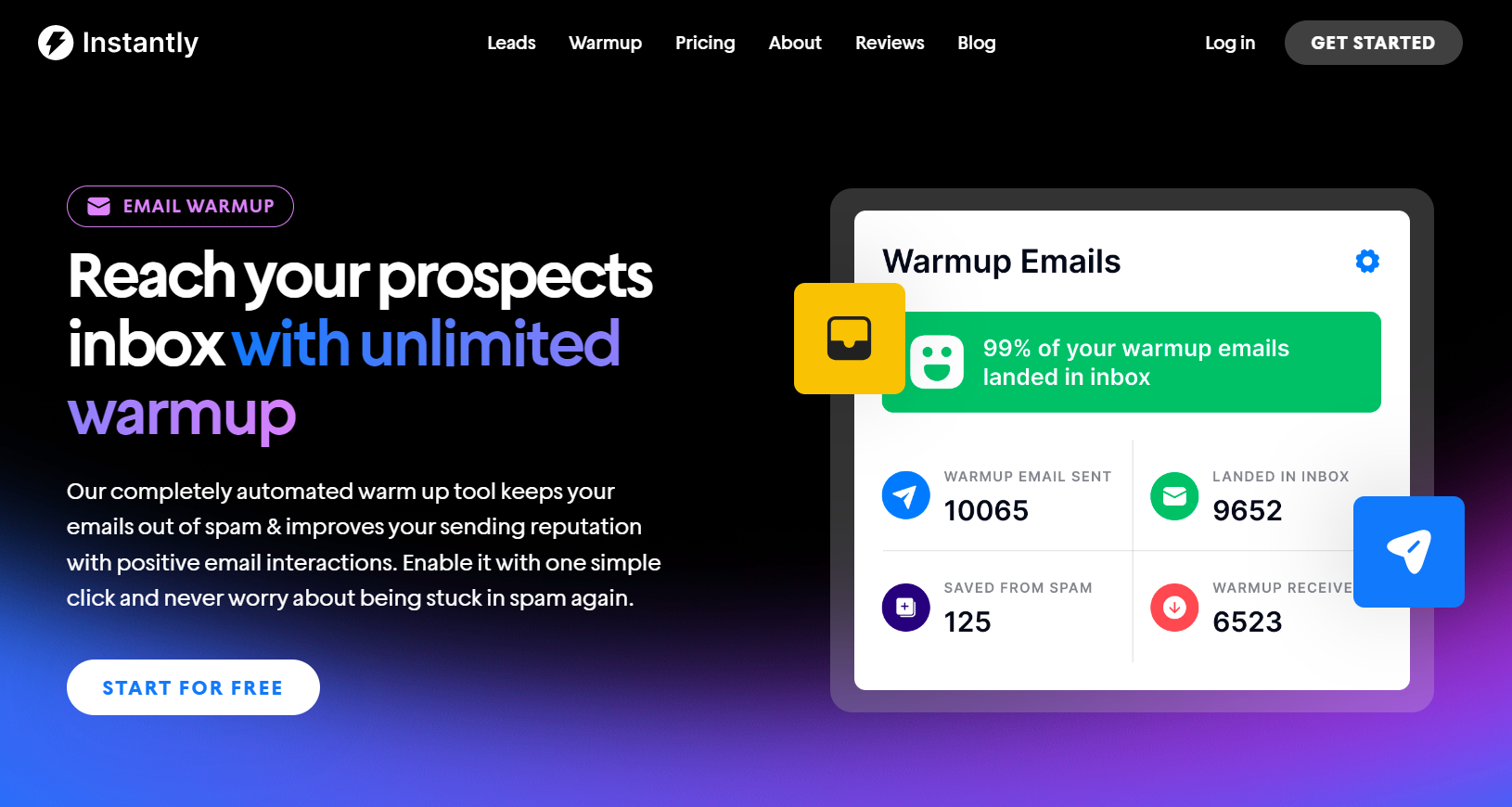Software companies have always been at the cutting edge of innovation. Lead generation for software companies relies on tactics driven by technological innovation.
Software businesses deliver modern solutions and regularly have to adapt to market conditions. The main issue, however, is how to stand out in a saturated market. Few software companies enjoy an endless flow of leads dropping into their inboxes. Instead, they rely on a strong lead generation strategy.
Lead generation isn’t just about quantity. These leads need to be quality. They need to be from the right audience, who have a genuine need for the software in question. In this article, we’ll share some of the most popular methods of lead generation for software companies. By the end, you’ll have answers to:
- Why does having a strong online presence matter for lead generation?
- Is an old strategy such as cold email still relevant for modern software companies?
- What tools can be leveraged to manage lead acquisition?
Understanding the Software Market
The software market is one of the most diverse markets. It encompasses everything from B2B marketing tools to dedicated consumer applications. There are hundreds of thousands of businesses that deliver software. It’s a popular market but one that comes as a double-edged sword.
Yes, there is a vast customer base. Almost every business in the world has use for some form of software. Individuals even more so. There is, however, a daunting amount of competition. Small startups with innovative ideas find themselves competing in a market against giants such as Adobe or Microsoft. It’s a big pie, but they certainly take the lion’s share of the portion.
Directly competing against these monsters requires focus. Focus on a particular sector of the market or niche. Defining a unique niche means that software businesses can target a smaller segment of the audience with a far more tailored message. That will set them apart from larger firms that aim to capture as much of the market as possible on a more general level.
This should always be the first question a software company asks itself before it launches into lead generation. “Who is our audience?” There might be many facets to the answer, but it should bring some clarity and guidance to your strategy.
Software companies tend to be born from innovation. It’s important to remember that. Constant innovation and adaptation should underpin the lead generation strategy. Failing to adhere to this means that businesses risk falling behind the curve. That means more innovative businesses will siphon leads.
Build A Strong Online Presence

Software companies are likely au fait with the requirement for a digital presence. It feels like it should be in their wheelhouse, but many don’t prioritize it. Instead, focusing on traditional, outbound lead generation techniques. Building a respected digital presence is a great way to generate leads. The best part is that they’re the inbound type of lead that comes to you rather than you chasing them.
Website Optimization
We’re not talking about SEO here (yet). We’re talking about the customer experience of your website. Often it’s the first interaction they have with you and your business. That means it needs to be a seamless, enjoyable experience for all users. It needs to be quick, responsive, and easy to navigate. That means including clear CTAs throughout that have an obvious task attributed to them.
You might also consider including some lead magnets on your website. These are things like guides, eBooks, whitepapers, and demos. In order to gain access to them, the user needs to part with their email address. That email address can be added to your database as a potential lead, especially for your email marketing efforts.
Content Marketing
The content that you put out is one of the primary ways that strangers to your business can get to know you. They might find a blog on a search engine. Someone might share one of your videos with them. Whatever the content is, once published, it’s always there working on your behalf.
When creating content, always consider what the user will get from it. What is the value of your content? They’re offering you their time, what do you have to offer in return? The more value you can offer upfront, the more trustworthy and respected you make yourself appear.
SEO and SEM
You’ve created the content, and now you want people to engage with it. That means you need your content to be found. If the content is hosted on your website, then you need to engage with some SEO tactics. This will help your content rank better for certain key phrases and get more eyes on the information that you’re sharing. SEM, while it still deals with search engines, is primarily focused on paid marketing efforts such as Google Ads to put your content at the top of the list. It can deliver instant results but requires diligent management, or you’ll quickly overspend your budget.
Social Media
There’s more to digital presence than your website and search engines. Social media plays a huge part in lead generation. It’s important to select a platform that you know your audience spends time on. There’s little point in investing in a TikTok campaign if none of your target market uses it.
Once you’ve selected appropriate platforms, you need to create content. That content should be engaging, informative, and relatable. Consider it in the same way as any other form of content marketing. Think about the value. Once the content is out there, and hopefully, your audience is engaging with it, you need to ensure that you also engage with them. Respond to comments, ask for feedback, and look to build a community around your brand.
Cold Email Marketing Campaigns

Email marketing is neither cutting-edge nor is it a brand-new innovation. This is a tried and tested method of lead generation that still works wonders today. It does, however, require a strategy of its own. Sending mass mailouts of generic templates isn’t going to get you anywhere. Instead, you need a strategy. That strategy should include:
- Personalization: At a minimum, look to address people by name. The best emails hang from a template but will include multiple personalized elements. You want the recipient of the email to feel that you’re addressing them individually.
- Segmentation: You’re already focusing on a niche. Now is the time to distill your audience even more. Break them into smaller groups or segments, and tailor your message accordingly.
- Follow-up: People rarely respond to the first cold email that they receive. They need to hear from you a few times before they consider hitting the reply button. Don’t fall into the trap of sending one email in a campaign and getting despondent when nobody replies.
- Preparation: Before you send a campaign, make sure that you have warmed up your account. You should have templates ready to use. Plus, you need to have verified your email list. The last thing you want is for your emails to hit the spam folder. If in doubt, make sure you test email deliverability.
Leveraging Modern Tools for Lead Generation
You’re not alone in the lead generation race. There is an evergrowing collection of tools that can help you to manage the whole process.
- Customer Relationship Management (CRM) Tools: Salesforce, HubSpot - CRM tools are excellent for keeping track of every lead that enters into your database. Track how they first engaged, what interactions they’ve had, and where they are on their customer journey.
- Email Marketing Tools: Instantly, Mailchimp - Email marketing tools are a necessity for any software business looking to launch cold email campaigns. The best will include email warmup as standard, extensive automation, and banks of email marketing templates that you can use.
- Analytics: Google Analytics, Ahrefs - You’ll want to set goals alongside your lead generation campaign so that you can measure success. Analytics tools provide the data to track those goals. Most businesses use Google Analytics and then pair it with in-software analytics from other tools.
Key Takeaways
Lead generation for software companies is certainly multi-faceted. There are many plates to spin and considerations to bear in mind. The key, within all of this, is to deliver value. Do that, and the leads will come naturally.
- The stronger your online presence, the better your foundations for lead generation will be.
- Cold email shouldn’t be underestimated as a tool for software company lead generation.
- Don’t be afraid to lean on a dedicated tech stack to assist in your lead generation strategy.
The most efficient lead-generating cold email marketing campaigns are run using a dedicated tool. A tool that helps you to generate content, assists with deliverability, and even helps you to source prospects. That’s precisely what Instantly offers, and you can get started with it today.





